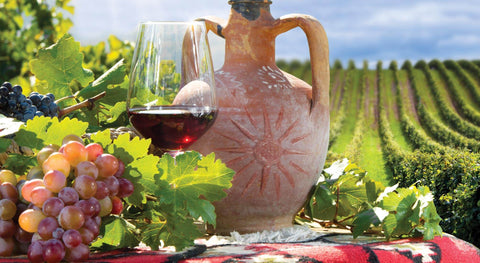Macedonian Wine!
Share
The Republic of Macedonia remains one of Europe’s last undiscovered wine countries: a natural paradise of vineyards, mountains, lakes and rivers, where life moves to a different rhythm, amidst the sprawling grandeur of rich historical ruins and idyllic villages that have remained practically unchanged for centuries.

In the late 1990’s, Macedonia’s wine industry entered a decade of intensive developments in grape growing and wine making with new wineries being built, old ones restructured, and leading producers and wine makers committing to put Macedonia on the international wine map.
Even though Macedonian wines might be new to many people, wine is not at all new to Macedonia. The country situated in the middle of Balkan Peninsula has been making wines from Ancient times. In this area, the vine used to be cultivated even 4,000 years ago. Many artefacts found on the ancient sites speak for the long tradition of grape growing. Part of these artefacts are drawings of grapes and vines carved in stone, marble and terracotta and can be seen in the museums in Macedonia, but a large number of these artefacts are now decorating the showcases of museums in Sofia, Belgrade, Berlin and others as well.

In the culture of Ancient Macedonia, which covered a larger geographical area than today’s Republic of Macedonia, wine played an important role. During the time of Philip II and Alexander the Great, members of the Macedonian royal family were known as strong consumers of Macedonian wine.
According to some historical sources, Alexander the Macedonian had a special servant called “wine pourer” whom had the sole task to serve his master with this beverage. Also, the Ancient Macedonians had a god of the wine named Dionis which further supports that they were known admirers of this drink.
At the time of the rise of Christianity, wine was part of almost all Orthodox Church ceremonies. The best grapes and wines were produced in the churches and monasteries, though their recipe was kept as the most sacred secret. In Christian religious customs, the wine is a symbol of Jesus Christ’s blood. Viticulture and wine producing as significant industries keep developing in the Middle Ages, and the evidence are several significant miniatures from the 10th century in the village Vatasa in Tikves region. The originals of several plays in which are seen digging and harvesting grapes, are today in the Vatican library.

Wine is mentioned in many folk songs, stories, legends, traditions and other elements of the folklore of this region. All chroniclers of Macedonian folk tales which acted in Macedonia in the 19th and the beginning of the 20th century mention wine as inevitable part of the folk customs and rituals.
GRAPE VARIETIES
It is believed that great wines can only be made from great grapes. Macedonia’s varied terrain offers a choice of vineyard locations. The fruit in our reds comes from lower altitude vineyards with rich, heavy, and clay–filled soils. In other vineyards, the cooler environment contributes to freshness and harmony in the white grape varieties, planted on lighter soils and at higher altitudes. Owing to the extremely favorable climate conditions, Macedonian eco-friendly grapes are sprayed only up to 4 time a year.
Macedonian indigenous varieties are something that you would not be able to find in any other place in the world. Examples include the Stanushina, which originates from the Tikves wine district where it is mostly widespread.
The main feature of this variety is its durability. There was a period in the past when it was about to become extinct because no one paid it any attention, but it survived.
Other local grape varieties include Smederevka, Zhilavka, Temjanka, Zupianka, Vranec and Kratoshiia, which are spread across 3 wine regions in 74 registered wineries, and bring in $50 million euros annually, 85% of which is exported to the international market that includes a total of 38 countries.


Source: www.winesofmacedonia.mk
